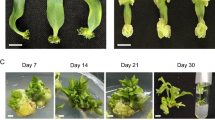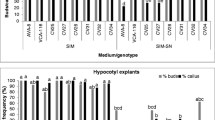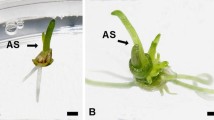Summary
The production of whole plants from explants of protein pea (Pisum sativum L.) using an efficient, reliable and rapid strategy, while maintaining trueness to type, will be required before regeneration can be exploited for genetic transformation. Seeds of the pea genotypes Terese, Solara, Frisson and P64 (a hypernodulating mutant line of Frisson) were surface-sterilized and imbibed overnight, whereafter embryo axes were dissected and germinated on hormone-free medium for 7–10 d. Hypocotyl sections lacking pre-existing meristems were harvested and cultured on a range of media with various concentrations and combinations of growth regulators in order to induce either caulogenesis or somatic embryogenesis. Differences in responsiveness were apparent between genotypes, but regeneration via caulogenesis was consistently more reliable than via the induction of somatic embryos. Few explants underwent somatic embryo production and their conversion into plants has remained elusive so far, irrespective of the genotype studied. Conversely, large numbers of buds were produced within 10 d by organogenesis, and healthy, rootable shoots were obtained. A clear relationship was observed between the growth regulators employed for bud regeneration and shoot rooting phases and the subsequent competence of the regenerated plants for flowering, pod formation and viable seed production.
Similar content being viewed by others
References
Bean, S. J.; Gooding, P. S.; Mullineaux, P. M.; Davies, D. R. A simple system for pea transformation. Plant Cell Rep. 16:513–519; 1997.
Bohmer, P.; Meyer, B.; Jacobsen, H.-J. Thidiazuron-induced high frequency shoot induction and plant regeneration in protoplast derived pea callus. Plant Cell Rep. 15:26–29; 1995.
de Kathen, A.; Jacobsen, H.-J. Agrobacterium tumefaciens-mediated transformation of Pisum sativum L. using binary and cointegrate vectors. Plant Cell Rep. 9:276–279; 1990.
Duc, G.; Messager, A. Mutagenesis of pea (Pisum sativum L.) and the isolation of mutants for nodulation and nitrogen fixation. Plant Sci. 60:207–213; 1989.
Gamborg, O. L.; Miller, R. A.; Ojima, K. Nutrient requirements of suspension cultures of soybean root cells. Exp. Cell Res. 50:151–158; 1968.
Griga, M.; Stejskal, J. Organogenesis and somatic embryogenesis in vitro in pea (Pisum sativum L., P. arvense L.) and field evaluation of somaclones—a preliminary report. XXIII Annual ESNA Meeting, Halle, Germany, 1993; 127.
Griga, M.; Tejklova, E.; Novak, F. J.; Kubalakova, M. In vitro clonal propagation of Pisum sativum L. Plant Cell Tiss. Org. Cult. 6:95–104; 1986.
Hussey, G.; Gunn, H. V. Plant production in pea (Pisum sativum L. cvs Puget and Upton) from long term callus with superficial meristems. Plant Sci. Lett. 37:143–148; 1984.
Jackson, J. A.; Hobbs, S. L. A. Rapid multiple shoot production from cotyledonary node explants of pea (Pisum sativum L.). In Vitro Cell Dev. Biol. 26:835–838; 1990.
Kosturkova, G.; Mehandjiev, A.; Dobreva, I.; Tzvetkova, V. Regeneration systems from immature embryos of Bulgarian pea genotypes. Plant Cell Tiss. Org. Cult. 48:139–142; 1997.
Lehminger-Mertens, R.; Jacobsen, H.-J. Plant regeneration from pea protoplasts via somatic embryogenesis. Plant Cell Rep. 8:379–382; 1989.
Loiseau, J.; Marche, C.; Le Deunf Y. Variability of somatic embryogenesis ability in the genus Pisum L.: effects of genotype, explant source and culture medium. Agronomie 16:299–308; 1996.
Mroginski, L. A.; Kartha, K. K. Tissue culture of legumes for crop improvement. Plant Breed. Rev. 2:215–264; 1984.
Murashige, T.; Skoog F. A revised medium for rapid growth and bioassays with tobacco tissue cultures. Physiol. Plant. 15:473–497; 1962.
Nauerby, B.; Madsen, M.; Christiansen, J.; Wyndaele, R. A rapid and efficient regeneration system for pea (Pisum sativum), suitable for transformation. Plant Cell Rep. 9:676–679; 1991.
Nielsen, S. V. S.; Poulsen, G. B.; Larsen, M. E. Regeneration of shoots from pea (Pisum sativum) hypocotyl explants. Physiol. Plant. 82:99–102; 1991.
Ozcan, S.; Barghchi, M.; Firek, S.; Draper, J. Efficient adventitious shoot regeneration and somatic embryogenesis in pea. Plant Cell Tiss. Org. Cult. 34:271–277; 1993.
Popiers, D.; Flandre, F.; Sangwan-Norreel, B. S. Intensification de la régénération du pois (Pisum sativum L.), par le thidiazuron, via la formation de structures caulinaires organogènes. Can. J. Bot. 75:492–500; 1997.
Puonti-Kaerlas, J.; Eriksson, T.; Engström, P. Production of transgenic pea (Pisum sativum L.) plants by Agrobacterium tumefaciens-mediated gene transfer. Theor. Appl. Genet. 80:246–252; 1990.
Sanago, M. H. M.; Shattuck, V. I.; Strommer, J. Rapid plant regeneration of pea using thidiazuron. Plant Cell Tiss. Org. Cult. 45:165–168; 1996.
Stejskal, J.; Griga, M. Somatic embryogenesis and plant regeneration in Pisum sativum L. Biol. Plant. 34:15–22; 1992.
Van den Berg, K.; De Craene, D.; Van Parijs, R. Cytogenetic effects of picloram on callus induction in Pisum sativum L. cultivar Finale. Meded. Rijksfac. Landbouwwet. Gent 56:1469–1481; 1991.
Van den Berg, K.; Van Oostveldt, P.; De Craene, D.; Van Parijs, R. The effect of phytohormones on callus induction in Pisum sativum L., cv. Finale. Meded. Rijksfac. Landbouwwet. Gent 54:1277–1286; 1989.
Van Doorne, L. E.; Marshall, G.; Kirkwood, R. C. Somatic embryogenesis in pea (Pisum sativum L.): effect of explant, genotype and culture conditions. Ann. Appl. Biol. 126:169–179; 1995.
Author information
Authors and Affiliations
Corresponding author
Rights and permissions
About this article
Cite this article
Ochatt, S.J., Pontécaille, C. & Rancillac, M. The growth regulators used for bud regeneration and shoot rooting affect the competence for flowering and seed set in regenerated plants of protein peas. In Vitro Cell.Dev.Biol.-Plant 36, 188–193 (2000). https://doi.org/10.1007/s11627-000-0035-1
Received:
Accepted:
Issue Date:
DOI: https://doi.org/10.1007/s11627-000-0035-1




